Thursday, January 31, 2019
This morning I woke up in Perú. Again.
For the second time in 5 months I find myself in Perú, but this is the first time I’ve been to this place. The ship is actually docked in a town on the southern outskirts of Trujillo called Salaverry. Salaverry is a very industrialized place with no particular interest to tourists. It looked like this when we were allowed to disembark:
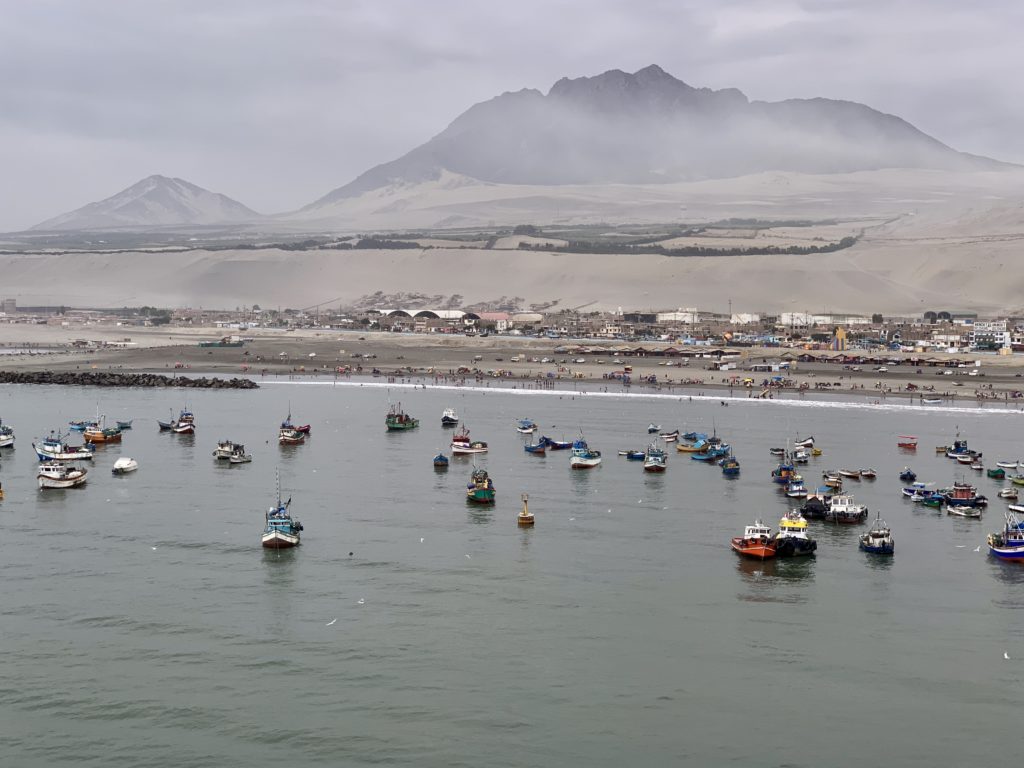
Perhaps the most notable feature of the area is a giant sand “wall” that separates the town of Salaverry from the mountains behind it. A closer inspection revealed that the wall of sand is slowly moving toward the water and has already started to engulf some of the makeshift housing in the area. On my tour today (more on that coming up) the guide explained that many of the houses we could see on the north side of town belong to squatters. They don’t own the land they’ve built upon, but nobody is attempting to take that land away, either.
Salaverry is a rather poor place. It looks depressed, like Naco, Sonora and makes Puerto Peñasco, Sonora, look like a true gem. But then, Salaverry is not the town I’m interested in today. I’m going to Trujillo.
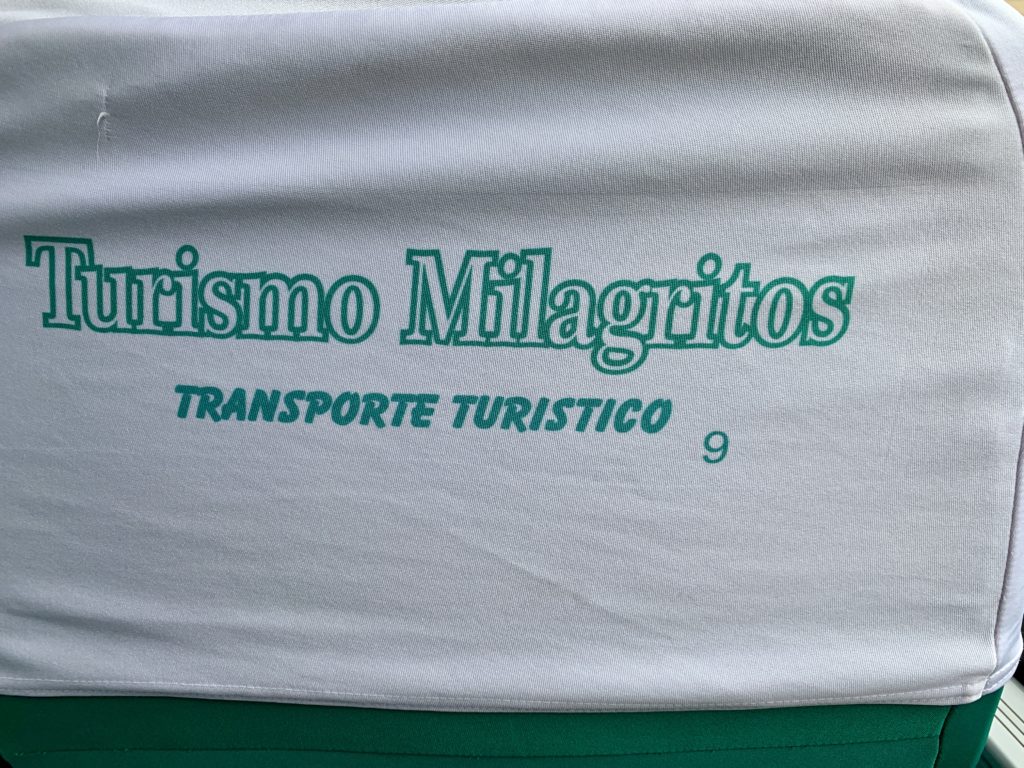
At the appointed time, our tour group disembarks and heads to the awaiting bus. I board the bus and choose my seat. There, on the seat back in from of me I read the name of this tour company: Turismo Milagritos. The literal English translation is “Little Miracles Tourism.” As I look around at the heavily industrialized and financially depressed town of Salaverry, I’m thinking that if we all get back without incident, it might be a little miracle, indeed.
The bus cruised quickly through the town of Salaverry and within a half an hour we were at the heart of Trujillo: the Plaza de Armas (or Plaza Mayor, as it is sometimes referred to.) I absolutely love to visit the central square in these Spanish colonial cities because they are all the same and yet every one is different.
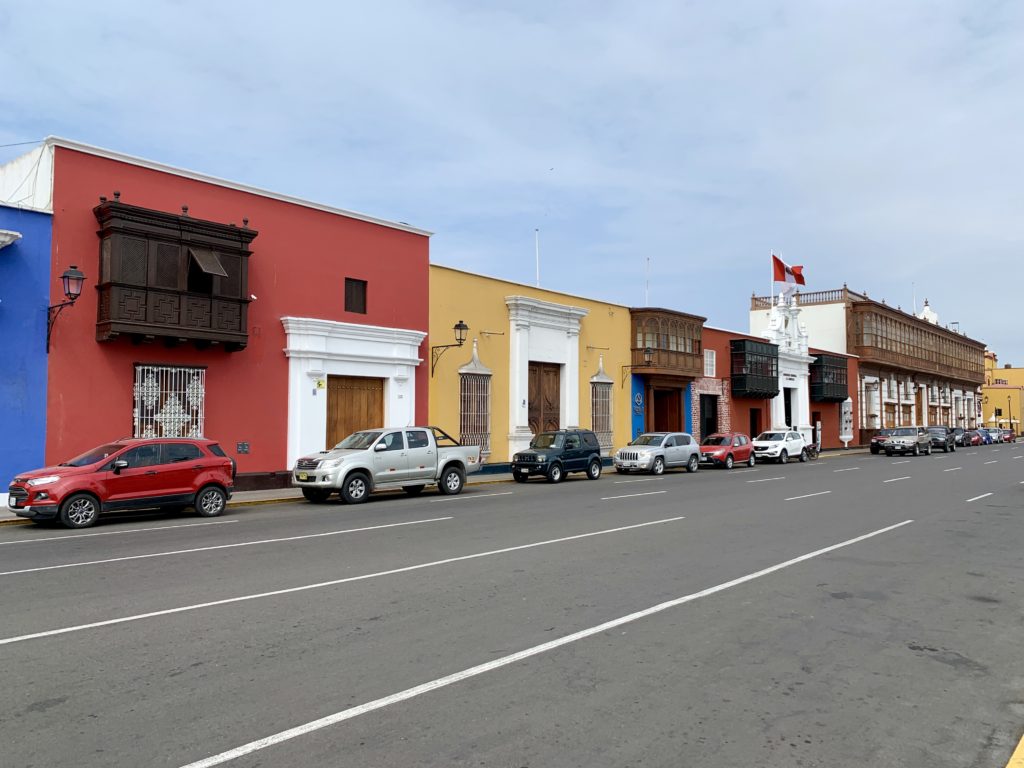
Government to one side… 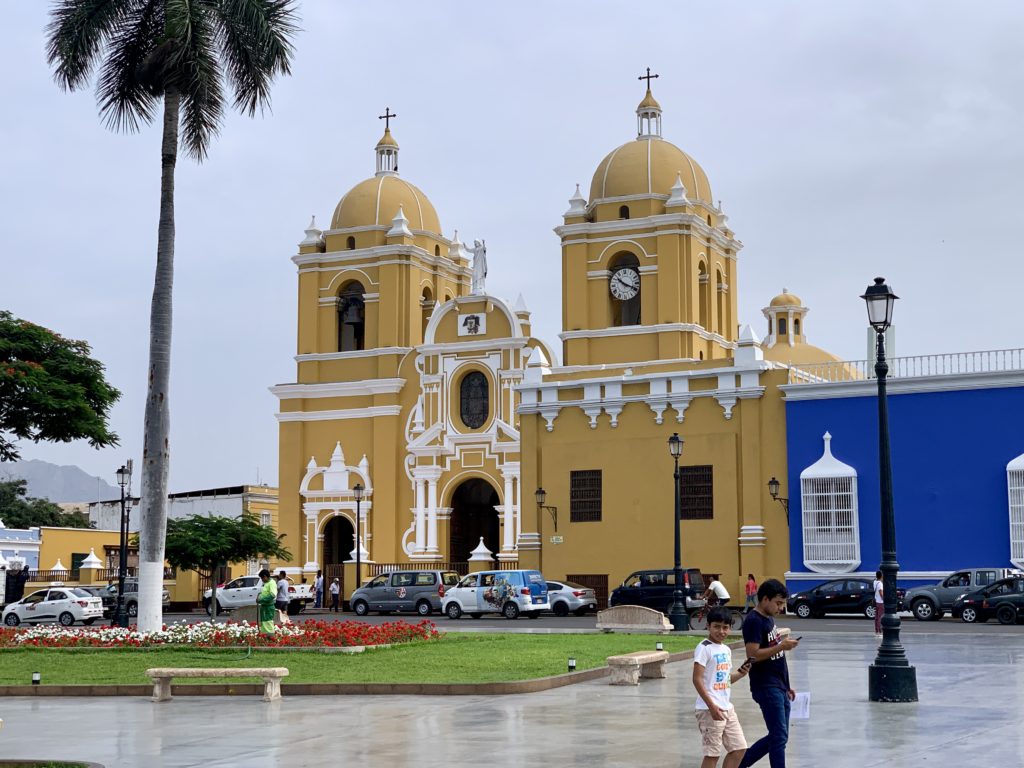
…the Church to the other.
Every Plaza de Armas that I’ve ever seen is a large, open area in the center of the city, usually a square or rectangular area. It always has the seat of government to one side, and a cathedral on the opposite side of the park. It is usually mixed with some commercial area, and must also contain monuments to local leaders, military men, and other historical events or cultural embodiments.
In Trujillo, the central monument is this guy:
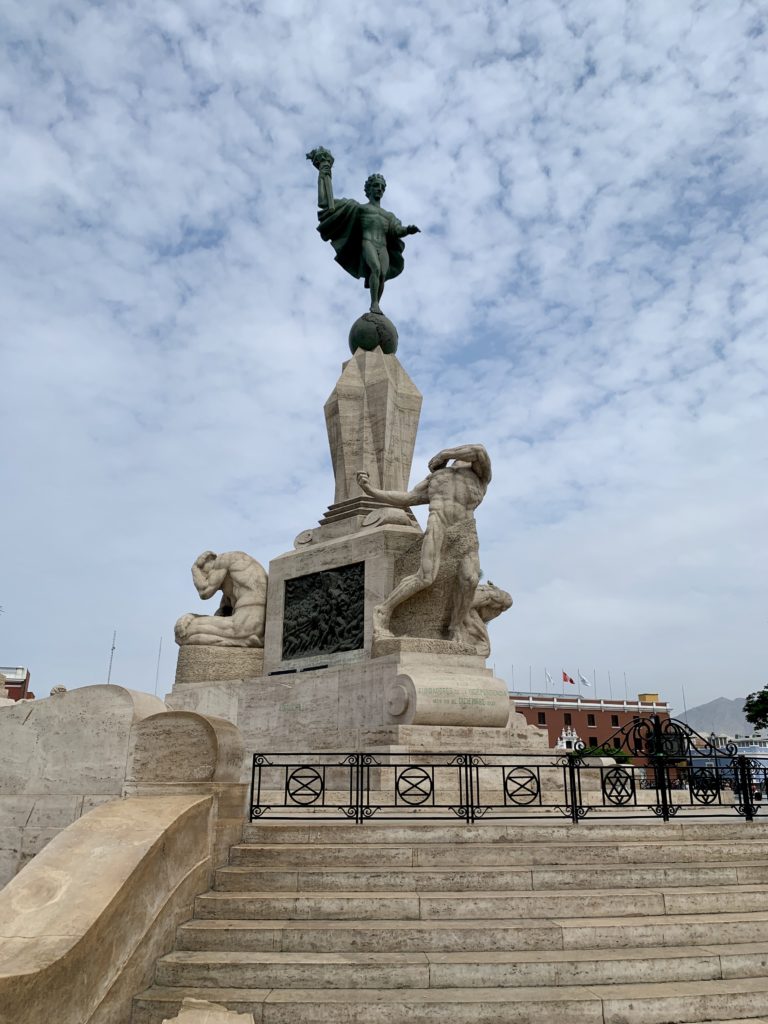
This guy, named Freedom, symbolizes freedom and celebrates Perú’s declaration of independence in 1820. It’s a beautiful piece, constructed with a stair-stepped foundation, upon which is placed a base for the bronze figure that is placed at the top.
Our guide told us to pay attention to the proportions of Freedom. In particular, she told us to look at the size of his chest and arms as compared with the size of his legs. Once you take a close look you can see that the legs appear far too short for the torso they hold up. Then she told us a story.
In the planning stages, this monument was designed to stand proud and tall in the plaza. A little too tall, it seems. The original design would have had the top of Freedom reaching a point higher than the highest point on the church. This was deemed by the city fathers (and, no doubt, the bishop) to be inappropriate. To them, nothing should rise higher than the House of God. As a result, the stair-stepped foundation was lowered slightly, but Freedom was likewise reduced in its stature. (Wow! The symbolism here is powerful!)
So, today, Freedom stands tall in Trujillo, but not quite as tall as religion. And, as a result, we have this oddly proportioned man, still trying to illuminate a dominated world. It’s a good story. Do I believe it? Well, I’ll concede that it’s a very good story. How’s that?
After a very brief stop at the Plaza de Armas, we rejoined our bus to head to the Huaca de la Luna in the Moche District near the mouth of the Moche river. The Huaca de la Luna, and the companion pyramid Huaca del Sol, are located at the base of a sacred mountain. The temple complex was believed to be an administrative and religious center for the Moche people. The Moche were an advanced tribe living in and around the Trujillo area long before there was a Trujillo. The Moche culture is very old. It is much older than the Incas. Archaeologists believe that the Moche culture, which lasted about 650 years, became the Chimú culture which lasted enough 600 years or so before they (the Chimú) were conquered by the Incas.
What is left of the Moche culture largely can be found in the area of these two huacas, or temples. The huacas are pyramids and the Huaca del Sol is the largest pyramid in Perú.
The huacas were built with adobe bricks, like those seen here:
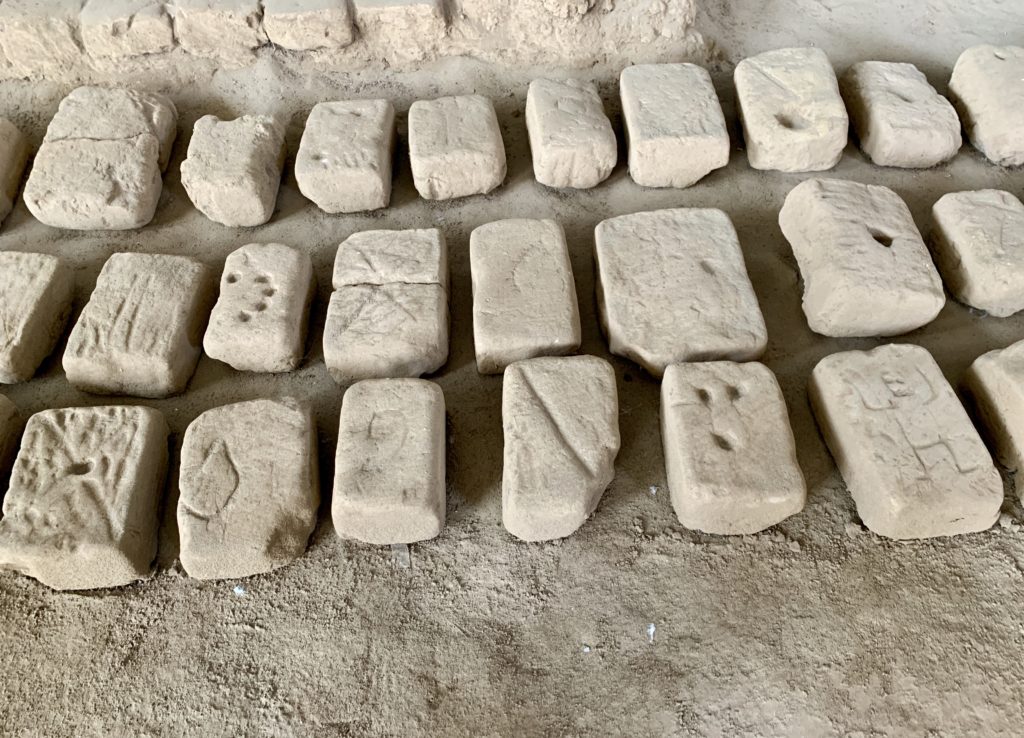
Bricks were created by individual families as a governmental tax. That is why each brick is marked in a manner that would identify the family who made it. The bricks would be gathered and used in the construction of the pyramids. The Huaca del Sol pyramid, at its peak (oooooo, bad pun), was constructed of 130 millions of these bricks!
The Huaca del Sol was looted and largely destroyed by the Spanish conquistadors and, following that, the elements continued to take their toll. The huaca is in poor condition and is not open to tourists. Therefore I’ll have little more to say about it.
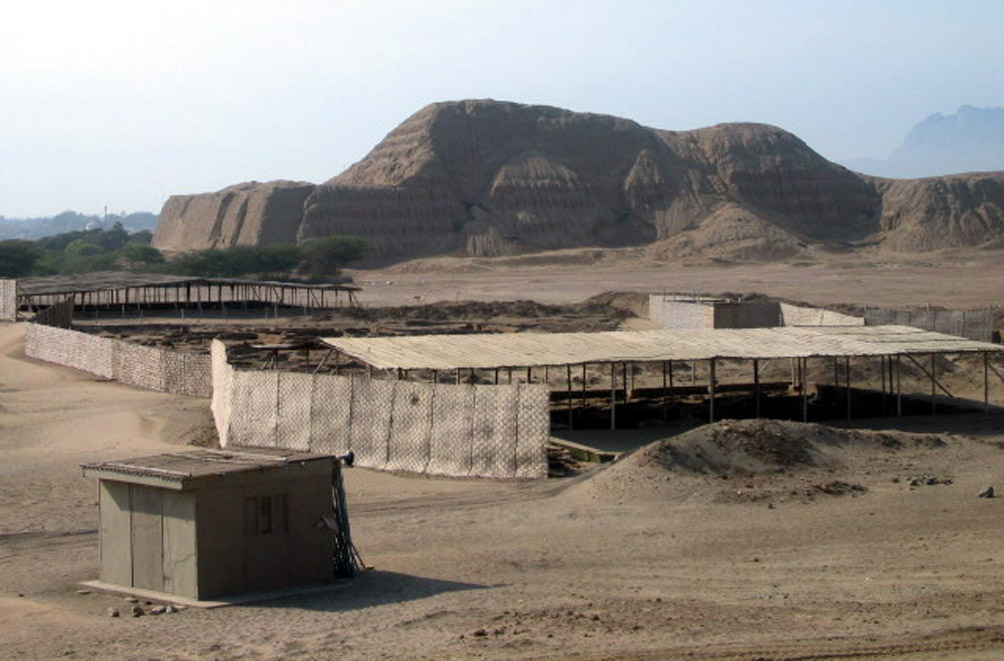
The Huaca de la Luna, on the other had, was open to view and it was full of amazing details. The huaca had been buried beneath a sand dune at the base of the sacred mountain and was not discovered until 1990. Because it had been buried for so long it is quite remarkably well preserved. It is so well preserved that many of the adobe walls within the huaca still retain their pigmented colors and are an indication that, in the past, the entire temple area was brightly colored.

We are also told that this huaca was built layer upon layer into its pyramidal shape. This photo shows several of the layers of the temple from the viewpoint of a large central square.
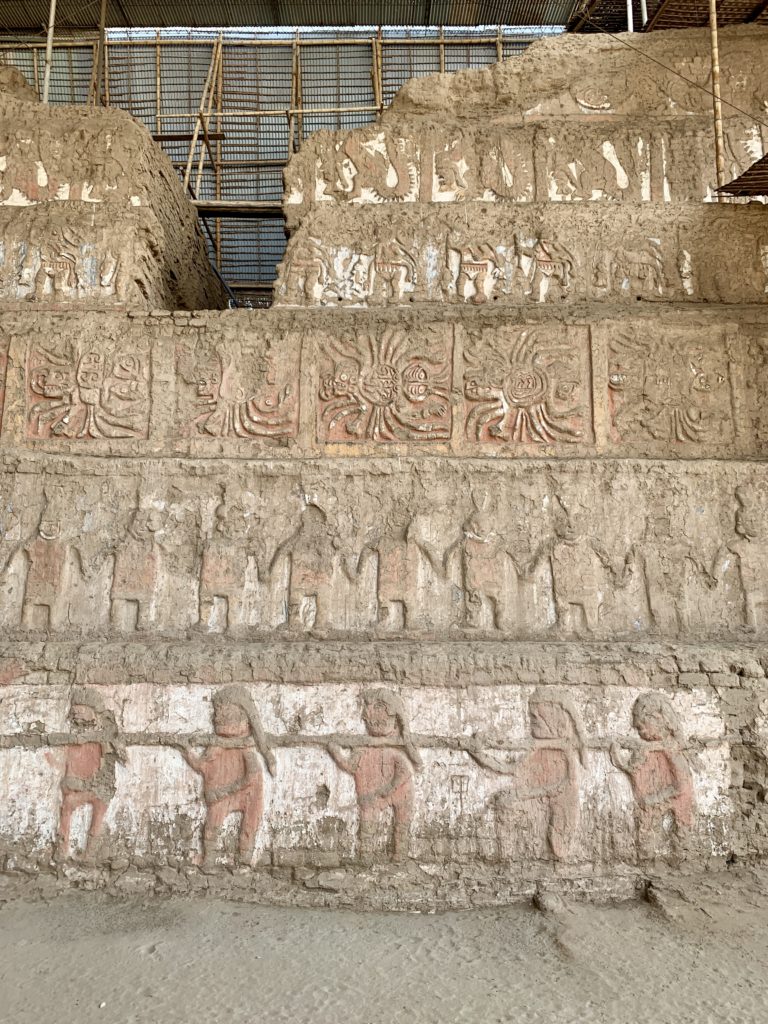
The bottom layer shows naked slaves chained together and led in procession. The Moche did practice human sacrifice and these slaves may depict that ceremony, or perhaps it is just intended to show the power and strength of the Moche people. Above that layer we have dancers, holding hands. Above that is a mythical symbol used by the Moche. It is a spider god that has a crab’s head for a backside. Very odd, but very creative.
The tour involved a lot of walking and little of it was on flat ground. I found the tour to be a good bit of exercise for mind and body alike. Ultimately, our short day in Trujillo had to come to an end, and our busload of weary tourists headed back to the dock in Salaverry and back aboard the Amsterdam.
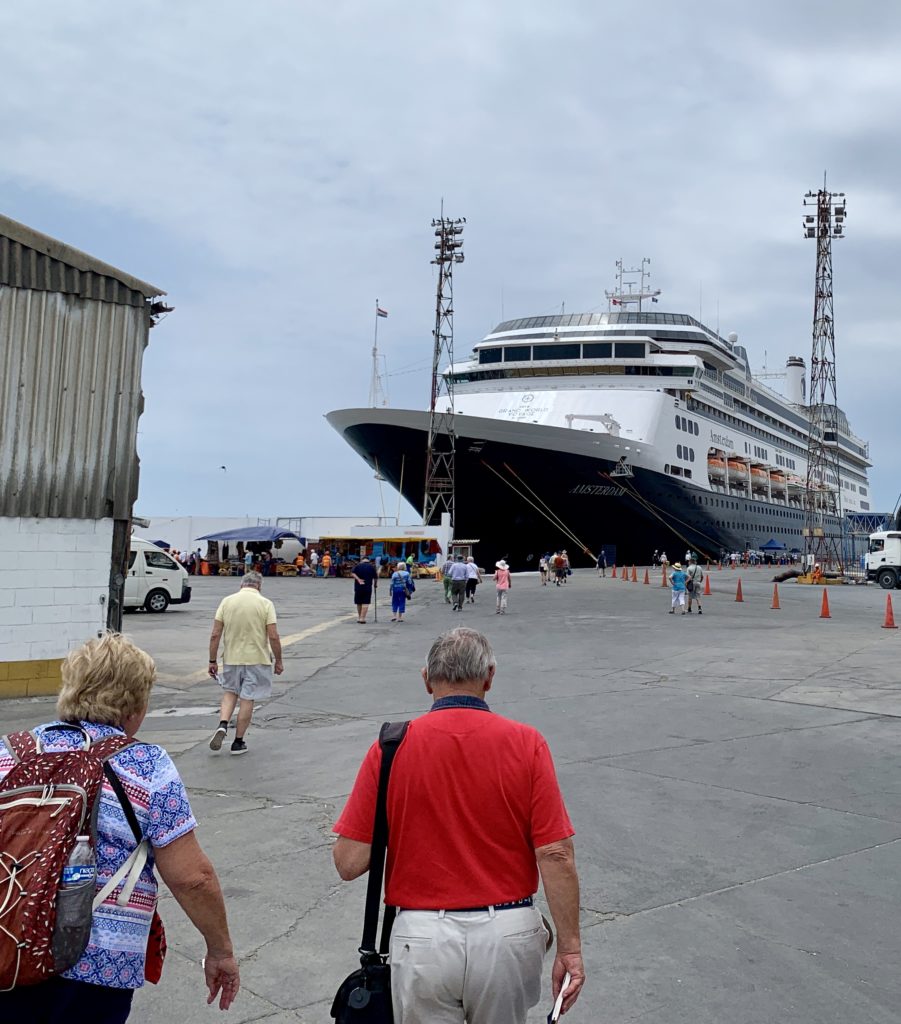
Once aboard and after a little “freshening up” it’s time for me to head to the Sea View Lounge on the Lido deck at the back of the ship. Each time we sail away from a port, the ship hosts a “Sail Away Happy Hour” and this is an event I hate to miss. There is something very exciting (to me, at least) to watch a place that I’ve just explored start to slowly recede into the distance. To watch the foam on the ocean created from our propellers as we sail away, and to see the lights in town start to twinkle to life, and to have a nearly-half-price beer in my hand, these are the things from which memories are made.
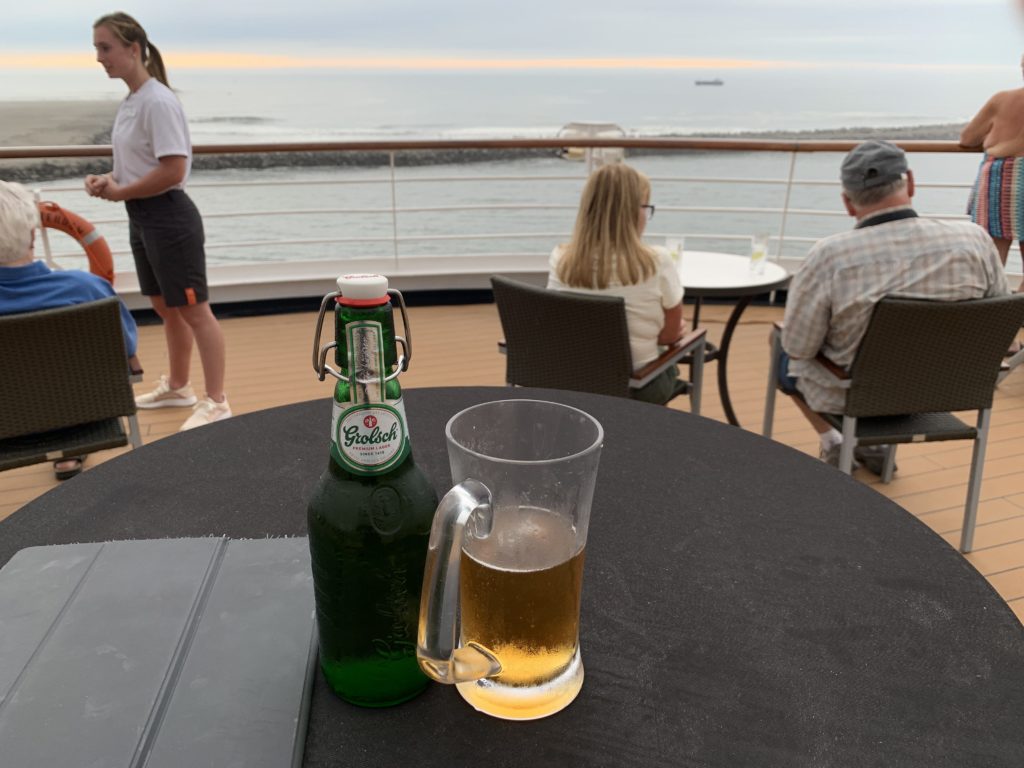
What is it?
Well, wasn’t this one a little stinker. For the longest time there were no correct guesses about what kind of animal this is. Even though I gave you all a nice clue that it was not a bear.
If you happen to follow me on Facebook, you received another clue, telling you to think “south of the equator.” At last some correct guesses came streaming in, and if you’re like Julie Tolle (and a few others) you correctly guessed that it is supposed to be a koala. Now, if you couldn’t figure it out for yourself, you’re in good company; I couldn’t figure it out myself and had to ask the animal’s creator, my cabin stewardess, Ayu.
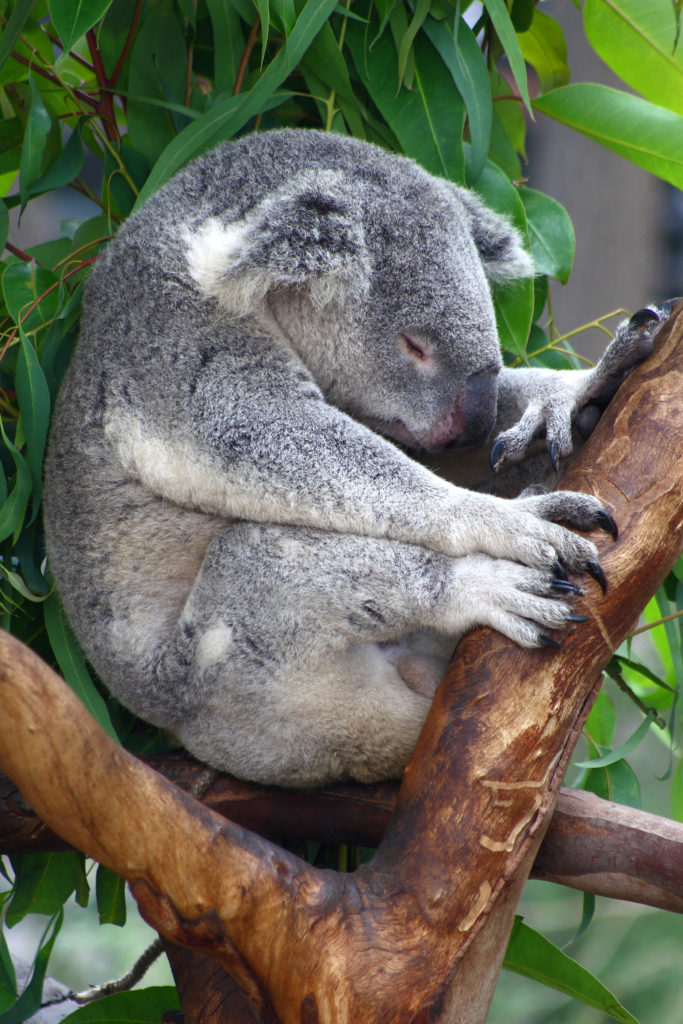
I have more photos of these crazy yet clever towel animals that I could share with you. Should I continue? Let me know.
You can comment directly from this site. If you are seeing this post as a single post on the past, the “reply” section at the bottom of the page is where you do that.
If you’re seeing this page with several posts on it, look on the left of the page at the start of the post to find a link to make comments.
G’night!

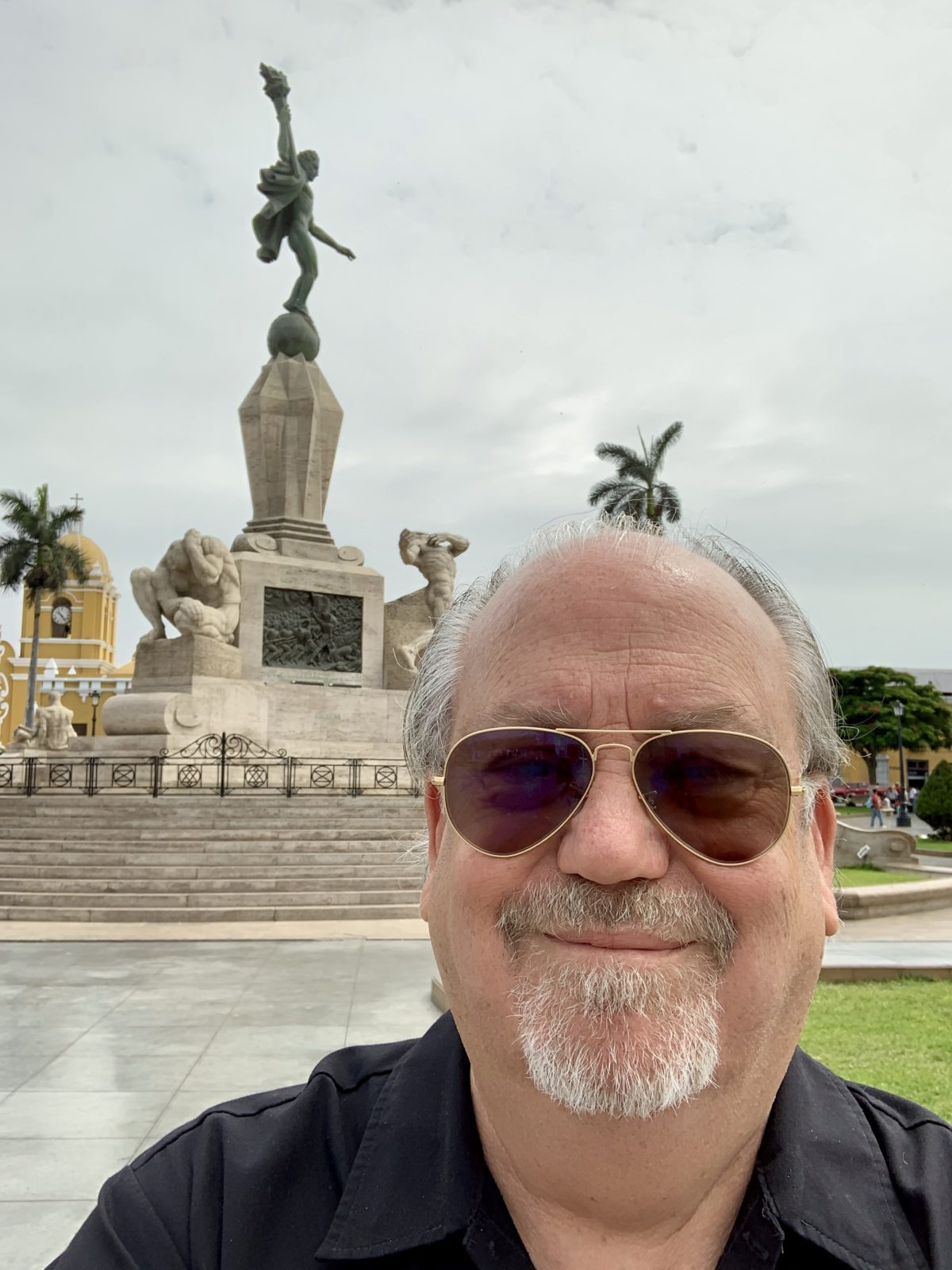
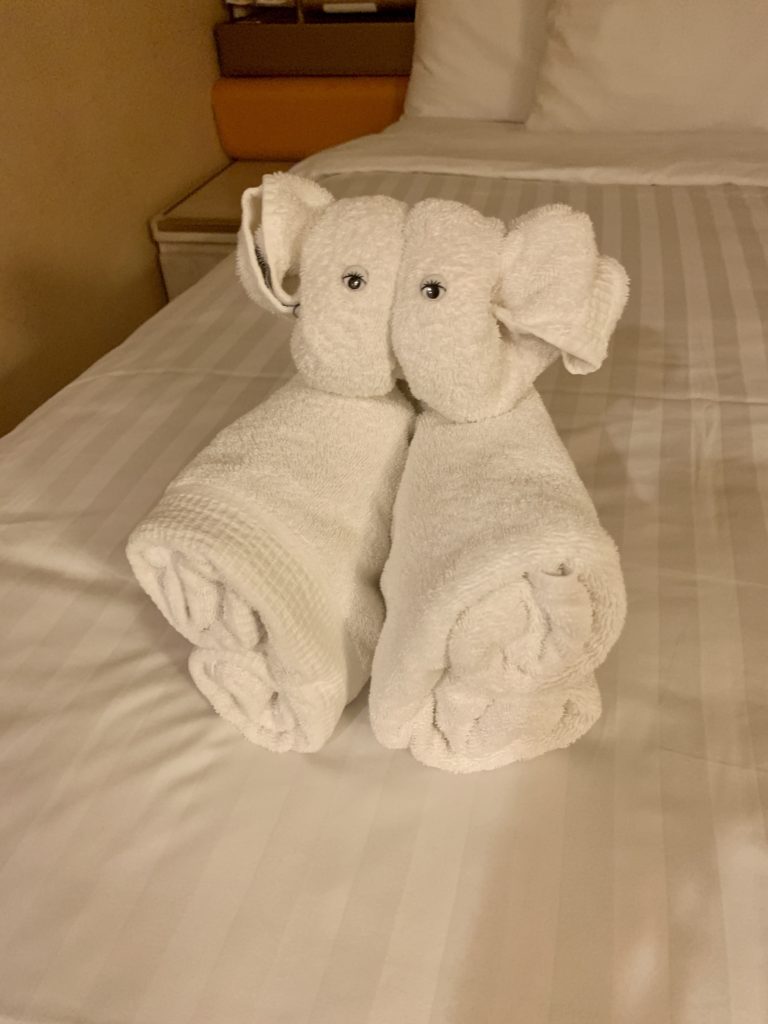
Love the blog. I enjoyed the history you shared and learning about what you and the blue hairs are up to. Sure! The towel creatures are fun too!
As soon as I receive notification you have posted, I click to read it immediately. I am loving your blog. Very entertaining. I also enjoy the “guess the towel animal” game, so my vote is for you to continue, please. You are looking very well-rested and relaxed. Traveling the world suits you. I especially like the photo for this entry with your adorable little “hat”. 😉
I concur! I love reading this blog and LOVE the towel animal game! Please continue to entertain your landlocked friends. I know I look forward to each and every new post!
Ditto on all three reply’s above.
Yay to everything! Please keep the towel animals coming too! Love being able to follow your adventures